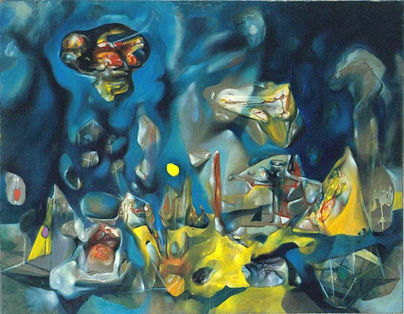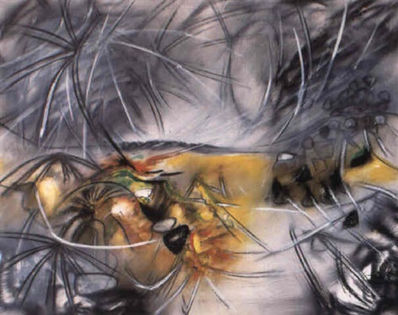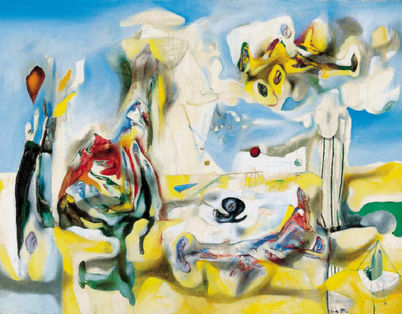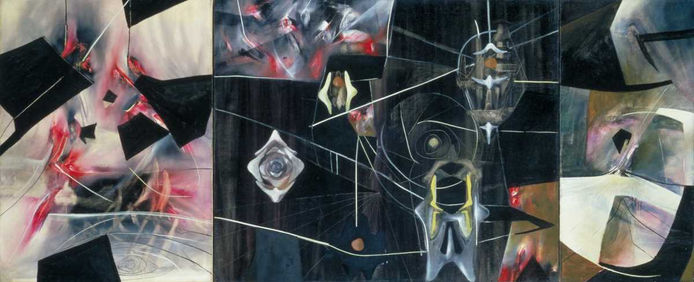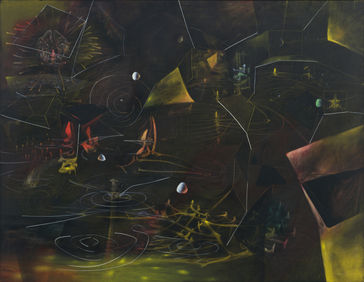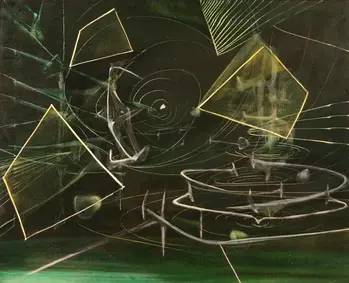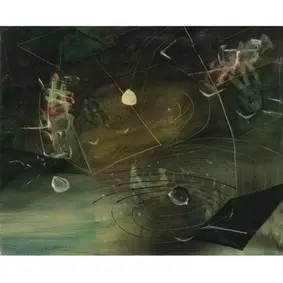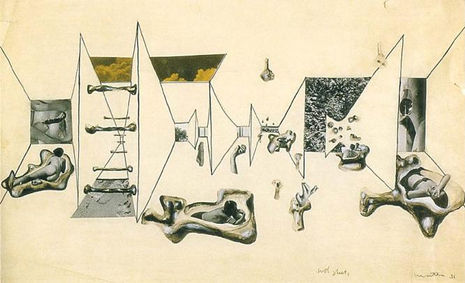For my further artistic practice I would like research the accelerating effect the implementation of digital technology and algorithms has on an individual.
For my further artistic practice I would like research the accelerating effect the implementation of digital technology and algorithms has on an individual.
Artworks and Processes
Artworks and Processes
Artworks and Processes
Artworks and Processes
Here is a heading
Ich bin ein Textabschnit. Klicke hier, um deinen eigenen Text hinzuzufügen und mich zu bearbeiten. Ich bin ein Textabschnitt. Klicke hier, um deinen eigenen Text hinzuzufügen und mich zu bearbeiten.Ich bin ein Textabschnitt. Klicke hier, um deinen eigenen Text hinzuzufügen und mich zu bearbeiten.Ich bin ein Textabschnitt. Ich bin ein Textabschnitt. Klicke hier, um deinen eigenen Text hinzuzufügen und mich zu bearbeiten. Ich bin ein Textabschnitt. Klicke hier, um deinen eigenen Text hinzuzufügen und mich zu bearbeiten.Ich bin ein Textabschnitt. Klicke hier, um deinen eigenen Text hinzuzufügen und mich zu bearbeiten.Ich bin ein Textabschnitt.
Here is a heading
Ich bin ein Textabschnit. Klicke hier, um deinen eigenen Text hinzuzufügen und mich zu bearbeiten. Ich bin ein Textabschnitt. Klicke hier, um deinen eigenen Text hinzuzufügen und mich zu bearbeiten.Ich bin ein Textabschnitt. Klicke hier, um deinen eigenen Text hinzuzufügen und mich zu bearbeiten.Ich bin ein Textabschnitt. Ich bin ein Textabschnitt. Klicke hier, um deinen eigenen Text hinzuzufügen und mich zu bearbeiten. Ich bin ein Textabschnitt. Klicke hier, um deinen eigenen Text hinzuzufügen und mich zu bearbeiten.Ich bin ein Textabschnitt. Klicke hier, um deinen eigenen Text hinzuzufügen und mich zu bearbeiten.Ich bin ein Textabschnitt.
Roberto Matta

© Roberto Matta, closeup
Euclid
postulated that visual rays proceed from the eyes onto objects, and that the different visual properties of the objects were determined by how the visual rays struck them. Here the red square is an actual object, while the yellow plane shows how the object is perceived. Whereas Plato and Empedocles thought of the visual ray as "luminous and ethereal emanation", Euclid’s treatment of vision in a mathematical way was part of the larger Hellenistic trend to quantify a whole range of scientific fields. Renaissance artists such as Brunelleschi, Alberti, and Dürer used Euclid's Optics in their own work on linear perspective. (Wikipedia)
“It is a space without limits and which transforms itself in time – a mutant space.”
– Roberto Matta
mutant space
Abstract Expressionism
machine-like and invertebrate shapes
looking glass into the psyche’s appearance
internal psyche as a landscape
the invisible made visible
fantastical, inward-looking narratives
cosmic creation and destruction dynamically charged cosmic space
fluctuating energy of the universe
time and space occur simultaneously
entering space of non-Euclidean geometry
complex, dynamic space
juxtaposition of mutable forms
representing unknown places
the ephemeral
Roberto Sebastián Antonio Matta Echaurren, “Matta,” is considered one of the great Surrealists and is widely acclaimed for his critical and catalytic influence on the development of Abstract Expressionism and on his contemporaries, including Jackson Pollock, Arshile Gorky, Mark Rothko and Robert Motherwell. (Pace)
Influenced by his association with the Surrealists, Matta began to develop his own visual language and, with his early works, the Inscape series and the Psychological Morphologies, which explored themes of cosmic creation and destruction. During the 1940s, Matta’s work featured machine-like and invertebrate shapes interacting in a dynamically charged cosmic space. (Obrist, 2003)
Fascinated by the fluctuating energy of the universe and rejecting the notion of a single vantage point, he created paintings and drawings with complex, dynamic space eventually incorporating social commentary into his work through figurative imagery. (Pace)
Employing the technique of automatism while painting and continuously following his impulses he made unpremeditated painting gestures, until reaching a point where they would be made unconsciously. This led Matta to believe that he would act as a channel through which he could appropriately represent on canvas the innermost parts of his psyche. Matta’s innovation was his ability to combine intuition and spontaneity with his knowledge of architectural spaces and interest in non-Euclidian geometry, to generate a uniquely recognizable style where the juxtaposition of apparently incongruent areas and mutable forms inhabit the same picture plane. (…) They act as interior landscapes of indefinable geometries and sensuality, a permeable looking glass into the psyche’s appearance, where time and space occur simultaneously. (Rosa, 2016)
"Inscape" series and the "Psychological Morphologies"
The series is understood as an expression of the internal psyche as a landscape. In both the 1940s and ‘50s Matta’s paintings featured machine-like shapes merging in cosmic spaces and during the ‘60s he produced works that addressed Latin American political and social issues. (Allitt, 2017)
He was one of the first painters of the modern era to attempt to visually depict the complexities of the human psyche in abstract forms, using his paintings ‘to make the invisible visible’. His masterful handling of paint and his poetic, mystical rendering of fantastical, cosmic spaces, inevitably make his works stand out as pre-eminent masterpieces of 20th century abstraction. Matta transformed the picture plane into a realm of fantastical, inward-looking narratives, where forms in perpetual motion produce eerie, oneiric effects, and result in radical images of faraway places that exist somewhere in the distant universe of his mind. Yet there is always a suggestion of a horizon line, of atmospheric depth, and linear perspective, that suggest we are looking at a landscape, albeit an imaginary one. This underlines Matta’s interest in the depiction of the psyche as interior landscape, supported by the rectangular format of his canvases, a format traditionally referred to as, not coincidentally, the ‘landscape format’. He uses contrasting tones between light and dark, giving certain areas in his paintings the sensation that they are glowing or of being filled with light. This may be best interpreted by relating it to his knowledge of Renaissance art, which employed the use of glazing – the gradual application of thin layers of paint on top of each other in order to achieve greater luminosity and sheen – when presenting holy subjects. (Rosa, 2016)
He believed that he needed to reach the innermost layers of his mind in order to be able to depict their true appearance, recalling the Platonic notion that we reside in a world where the visible is a mere echo of the true form of things. By collapsing the boundaries between architectural space, landscape, and the subject that perceives it, Matta brings us to a location where all three coincide by means of material sensuality. He was interested in only representing unknown places. (Rosa, 2016)
Black virtue, 1943 / In vertigo of eros, 1944 / Children’s fear of idols, 1943 / Children’s fear of idols II, 1944 / Sketch called "wet-sheets"
Selected passages
Resistor: Surrealist Roberto Matta interviewed before his death – Hans Ulrich Obrist
Interview 1 April 2003
Chance
”That is an excellent idea because I am very interested in chance. For me, it is the best of things. It is a game between series. Chance rolls on and never stops. It’s like the random button on a CD player. The numbers continually roll over and do not stop, as if they are caught in a sphere. They turn and turn and then stop by chance on a track. We are like these numbers. We are rocked and bombarded from above and below, from right and left. We are a target and bombarded from all sides. This is the administration of chance, a serial chance. Chance plays a very important role in my conception of architecture, for example.”
Mutant space
”I was interested in other spaces to do with forms drawn from non-Euclidean geometry and the idea of entering these spaces. These structures do not rely on the sense of space, as we know it. It is a space without limits and which transforms itself in time – a mutant space. It is the same thing with a representation of a fly’s eye, or rather the way in which a fly sees us. What it sees certainly does not resemble what we see. We are transformed in the fly’s vision. It is not a photo.”
Perspective
”… people will understand only after a revolution in geometry, in a hundred years. Nevertheless, artists continue to work always in the same manner, working on their small arrangement taken from Euclid.”
Hans-Ulrich Obrist: (...)This is what struck me when I saw your architectural drawings: these pluri-dimensional, non-linear cities. They are a premonition of things to come in urbanism.
Resistance
”Resistance is in each of us. We resist by exercising our creativity. That is true poetry – when we seek new comparisons, other ways of looking and conceiving of things. Many people believed that resistance was only a union thing, a struggle that profited the unions. But unions organised the working class with promises that could never be achieved. We lived for a century with a bad interpretation of Marx.”
Utopia and invention
”All that I thought was transmitted by oral means. And everyone interpreted the things that I said differently. Nothing is fixed on paper. It’s better like that. To act as creator, to look for comparisons between things in order to capture them, is to invent. Otherwise, it is recitation. You repeat others. It is not what I have said that is important, it is the way that you heard it, that you understood it and the way that you will, starting from that point, move forward with your own work.”
On Gilles Deleuze
”I knew Felix Guattari very well. Because since the beginning, I have spoken about psychological morphologies. For a long time, I have known that geometry is not within everybody’s psychology. They read, as it is possible for them to read, by projecting their own images. They read with their own images and not with the images that the author wants to impose on them when he writes. (…) We can only imagine what the dreams of others are by looking at our own.”
Architecture
“Architecture should rest on the ideas of Einstein and new geometry. Man is constantly changing and everyone should understand that others change as we change. So, there should be no edifices, no possessions – there should only be the ephemeral. It is like football. What I mean is that when you play football, you win a match but that does not mean you have won for all of your life. Next time, you might lose. But we have difficulty understanding that. We tend to believe that once we have obtained something, it is ours forever.”
References
Allitt, F (2017) Chilean Surrealist painter Roberto Matta stars at Robilant + Voena’s Art Basel Miami Beach stand. Available at: https://www.antiquestradegazette.com/news/2017/chilean-surrealist-painter-roberto-matta-stars-at-robilant-plus-voena-s-art-basel-miami-beach-stand/ (Accessed: 06.11.22)
Obrist, H (2003) Resistor: Surrealist Roberto Matta interviewed before his death. Tate Research Publication. Available at: https://www.tate.org.uk/art/artists/matta-1594/resistor (Accessed: 06.11.22)
Pace (n.a.) Roberto Matta. Available at: https://www.pacegallery.com/artists/roberto-matta/ (Accessed: 06.11.22)
Rosa, F (2016) Roberto Matta: Chilean Abstract Expressionist. Available at: https://theculturetrip.com/europe/france/paris/articles/roberto-matta-the-architect-s-dream/ (Accessed: 07.11.22)
Wikipedia (n.a) Euclid's Optics. Available at: https://en.wikipedia.org/wiki/Euclid's_Optics (Accessed: 06.11.22)

